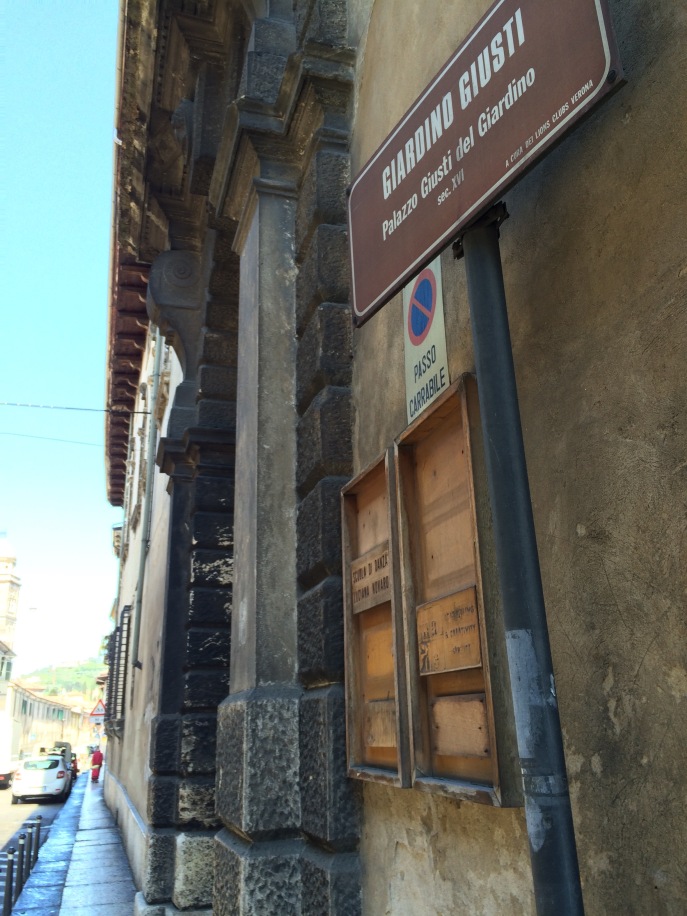A few weeks ago I introduced the Giardino Giusti and began to describe our visit there. It’s been just a few months since we left Italy, but it feels like ages right now. As I said before, the garden is simply incredible and the plants found there are all part of what I’d consider the traditional Italian garden. Maybe the photo collage is too small, but above on the far left you’ll see Acanthus mollis, some jasmine, and a hellebore with an Italian terra-cotta planter on a classical Roman-style pedestal. In the middle image you’ll notice the Italian cypresses flanking the perfectly painted Italian building. These trees are used to the extreme in this garden, oh, and that last pic on the far right, the boxwood! Oh, the boxwood! There’s architectural remnants too—but course.
Up the stairs in the lower garden there is an orangerie, although I cannot remember what to call it in Italian. Beyond it there’s an area dedicated to Brugmansia, but they were only just beginning to grow again after having been planted out. (I assume they’re protected over the winter.) Above this area, you can see a lovely structure which you’re able to walk up to in order the sit and enjoy the view below of the garden and town itself.
The flowers in this area were mostly Iris. The many citrus plants were blooming and the scent of their blooms was intoxicating. Along a wall, for the second time during an Italian vacation, I saw caper plants growing.

Looking back towards the entrance to the garden, I noted this row of statuary lined up above a roof’s edge. My husband recognized the style of dress and the symbols each held and they essentially represent the classes. There’s nobility, military, clergy, and a peasant. What’s missing is the piece that was up above the other 4. If I had to guess, it may have been religious, but I’m not certain. (My guess at the 4 statues representing the classes is a guess as well, but it’s and educated one.)
Protected in this area is the lovely Citron fruit. These lovely structures are so simple. The fruits were so happy and snug growing against their wall.
Sadly I cannot remember right now what this area had been, but I do remember the little pockets in the walls.
Before heading up the lovely path I had a lesson in Italian. I made the mistake of goofily pronouncing belvedere as we would in English, as I had learned as a kid from watching Mr. Belvedere. My husband lost it. When he lost it, I lost it cracking up at him. Then I had to laugh at how to correctly pronounce the word in Italian—bell-va-dare-aye. I felt so stylish. Of course this led to me talking about Signore Bell-va-dare-aye! It doesn’t take much for me to have fun, now does it? Turns out that to my husband “Belvedere” is somehow sacred. Yes, it means “viewpoint” if you hadn’t figured that out already.

I guess when you have a view like this, you might want to take it seriously.
Next post, you’ll be seeing a bit more of it.
























 Created in the sixteenth-century, this is an Italian Renaissance garden. There are many styles of gardens in Europe—and I’m still far from an expert on this subject—but seeing this garden really inspired me to learn more. (I think my next trip will most certainly be a more in-depth exploration of great gardens.)
Created in the sixteenth-century, this is an Italian Renaissance garden. There are many styles of gardens in Europe—and I’m still far from an expert on this subject—but seeing this garden really inspired me to learn more. (I think my next trip will most certainly be a more in-depth exploration of great gardens.)







 It truly is a feast for your eyes and why not send your husband off into the labyrinth? I was fairly certain that Minos was still in Greece and that John would not encounter a minotaur here although I thought about it. That’s what these gardens were intended for, and so I let my mind be transported back to the ancient classical stories of Italy and Greece. (I should also add that all references to Catholicism have been removed. I will get to that in later posts as well.)
It truly is a feast for your eyes and why not send your husband off into the labyrinth? I was fairly certain that Minos was still in Greece and that John would not encounter a minotaur here although I thought about it. That’s what these gardens were intended for, and so I let my mind be transported back to the ancient classical stories of Italy and Greece. (I should also add that all references to Catholicism have been removed. I will get to that in later posts as well.) It should come as no great surprise to you that food is important in Italy and all great Italian gardens will have citrus. The lemon is known to have arrived in Italy during the time of classical Rome.
It should come as no great surprise to you that food is important in Italy and all great Italian gardens will have citrus. The lemon is known to have arrived in Italy during the time of classical Rome. In the next two posts we’ll walk to the top of the garden. This is a garden seen in layers, with so many beautifully designed angles. Everywhere you look, you see beauty.
In the next two posts we’ll walk to the top of the garden. This is a garden seen in layers, with so many beautifully designed angles. Everywhere you look, you see beauty.






